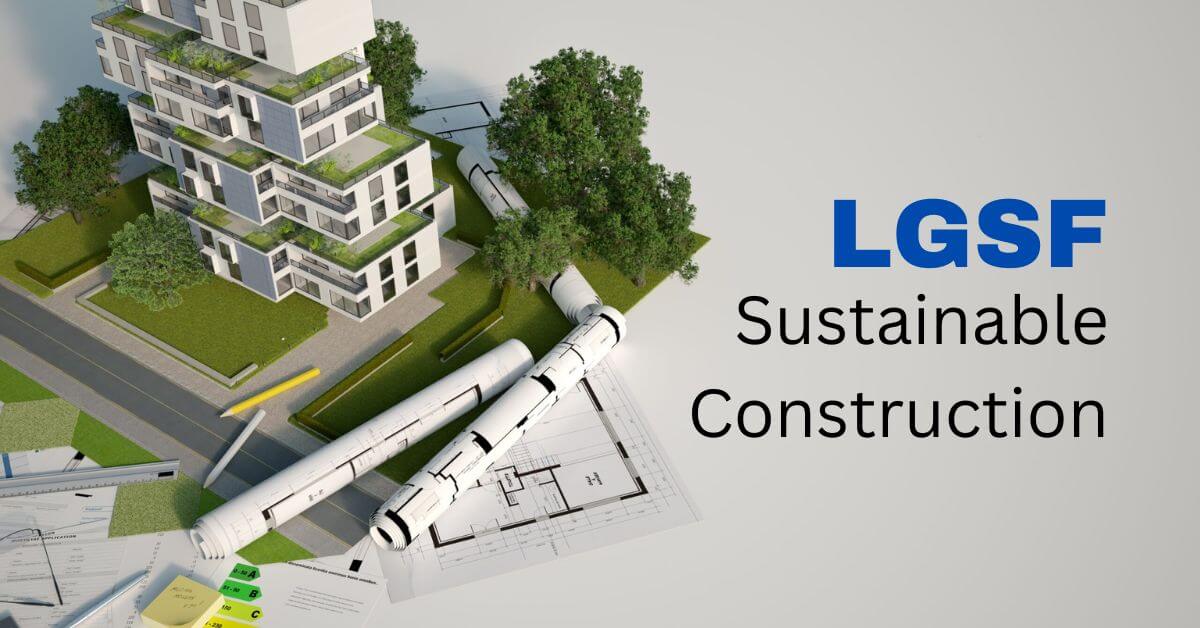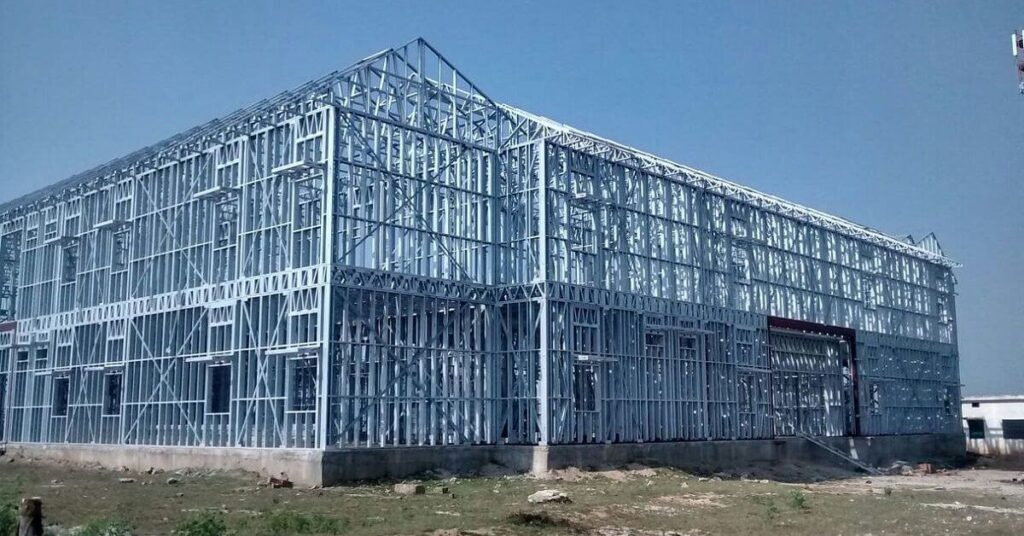
- By: indueprefab
- Date: Jan 08, 2024
- Comment: 0
- Category: Floor extension, lgsf companies in india, lgsf structure manufacturers in india, Prefab companies in india, Uncategorized
Light Gauge Steel Framing: Paving the Way for Sustainable Construction
In recent years, the construction industry has experienced a paradigm shift towards sustainable and eco-friendly building practices. As environmental concerns continue to grow, architects, engineers, and developers are increasingly turning to innovative materials and construction methods to reduce the carbon footprint of buildings. One such revolutionary approach gaining traction is Light Gauge Steel Framing (LGSF). This construction method not only offers structural integrity and cost efficiency but also positions itself as the future of sustainable construction.

Benefits of Light Gauge Steel Framing:
- Resource Efficiency:
Light Gauge Steel Framing employs thin sheets of high-strength steel, which is a highly resource-efficient material. The production of steel involves a significantly lower amount of energy compared to traditional construction materials like concrete and wood. Additionally, steel is 100% recyclable, making it a sustainable choice for building materials. - Reduced Waste:
Traditional construction often generates substantial waste, with excess materials and construction debris being sent to landfills. Light Gauge Steel Framing, however, is precision-engineered, resulting in minimal on-site waste. The accuracy of factory-made components ensures that materials are used efficiently, reducing the overall environmental impact of the construction process. - Energy Efficiency:
Light Gauge Steel Framing contributes to energy-efficient buildings by allowing for better insulation and airtight construction. The framing system accommodates thicker insulation, enhancing the building’s thermal performance. This translates into lower energy consumption for heating and cooling, reducing a structure’s long-term environmental impact. - Durability and Longevity:
Steel, known for its durability, is resistant to common construction issues such as rot, warping, and pests. Light Gauge Steel Framing structures have a longer lifespan compared to traditional wooden framing, resulting in fewer replacements and less material consumption over time. - Design Flexibility:
LGSF offers architects and builders greater flexibility in design. The lightweight nature of steel framing allows for larger spans and open spaces, promoting innovative and modern architectural designs. This adaptability fosters the creation of sustainable, energy-efficient structures that meet the evolving needs of the construction industry. - Resilience to Natural Disasters:
Steel-framed structures exhibit superior resilience to natural disasters such as earthquakes, hurricanes, and fires. This resilience not only ensures the safety of occupants but also reduces the need for frequent reconstruction, minimizing the environmental impact associated with rebuilding damaged structures.
Discover the future of sustainable construction with Light Gauge Steel Framing. Explore the innovative solutions that this advanced building technique offers for eco-friendly and resilient structures.
Conclusion:
As the world continues to prioritize sustainability, Light Gauge Steel Framing emerges as a frontrunner in the construction industry’s journey towards environmentally friendly practices. The benefits of resource efficiency, reduced waste, energy efficiency, durability, design flexibility, and resilience make LGSF a compelling choice for builders and developers committed to creating sustainable structures.
In a future where sustainable construction is not just a preference but a necessity, Light Gauge Steel Framing stands out as a reliable, efficient, and eco-friendly solution. Embracing this innovative construction method not only aligns with global environmental goals but also paves the way for a more sustainable and resilient built environment.
People also ask about Light Gauge Steel Framing – The Future of Sustainable Construction
- What is Light Gauge Steel Framing (LGSF)?
- Light Gauge Steel Framing involves using cold-formed steel sections to create a structural framework for buildings. These sections are typically thin sheets of steel that are formed into C or Z shapes.
- How does LGSF contribute to sustainable construction?
- LGSF is considered sustainable as it utilizes recycled steel, reducing the demand for new raw materials. Additionally, steel is highly recyclable, making it an eco-friendly choice for construction.
- Is Light Gauge Steel Framing suitable for residential construction?
- Yes, LGSF is widely used in residential construction. It provides a durable and lightweight alternative to traditional wood framing, and it is resistant to common issues like warping, rot, and termite damage.
- What are the key advantages of LGSF over traditional construction methods?
- LGSF offers advantages such as durability, resistance to pests, fire resistance, precision in manufacturing, and speed of construction. It also minimizes waste and is highly customizable.
- How does LGSF compare to wood framing in terms of sustainability?
- LGSF is often considered more sustainable than wood framing due to its use of recycled steel and reduced environmental impact. Unlike wood, it is not susceptible to decay, reducing the need for chemical treatments.
- Can LGSF be used for multi-story buildings?
- Yes, LGSF is suitable for multi-story construction. Its strength-to-weight ratio makes it an excellent choice for tall buildings, and it can be engineered to meet various structural requirements.
- Is Light Gauge Steel Framing cost-effective?
- While the initial material cost of steel may be higher than wood, LGSF’s durability, reduced maintenance costs, and faster construction times often result in overall cost savings.
- Does LGSF have any limitations in terms of design flexibility?
- No, LGSF is highly versatile in terms of design. It allows for various architectural styles and can accommodate complex building designs. Computer-aided design (CAD) technologies enhance precision.
- Is LGSF suitable for regions with seismic activity?
- Yes, LGSF has excellent seismic performance. The flexibility and strength of steel make it a resilient choice for areas prone to earthquakes.
- How does LGSF contribute to energy efficiency?
- LGSF structures can incorporate insulation materials easily, improving energy efficiency. The reduced thermal bridging of steel compared to wood can contribute to better overall energy performance.
- What is the lifespan of a building constructed with LGSF?
- Buildings with LGSF can have a longer lifespan compared to traditional materials. Steel is resistant to many environmental factors, and proper maintenance can extend the life of the structure.
- Is Light Gauge Steel Framing environmentally friendly?
- Yes, LGSF is considered environmentally friendly due to its use of recycled materials, minimal waste during construction, and steel’s recyclability at the end of the building’s life.
- Does LGSF comply with building codes and standards?
- Yes, LGSF systems are designed and tested to meet or exceed building codes and standards. It is essential to work with experienced professionals to ensure compliance with local regulations.
- Can LGSF be combined with other construction materials?
- Yes, LGSF can be integrated with other materials such as concrete, glass, and wood, allowing for diverse architectural designs and meeting specific project requirements.
- Are there any notable projects that showcase the use of Light Gauge Steel Framing?
- Yes, numerous commercial, residential, and industrial projects globally have successfully utilized LGSF. These include apartment complexes, schools, and even large-scale infrastructure developments, highlighting its versatility and reliability.
